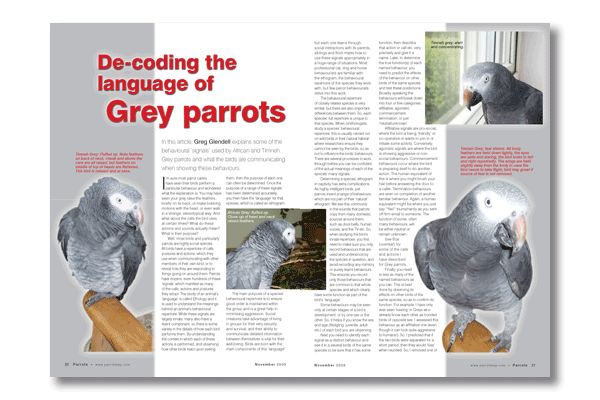DE-CODING THE LANGUAGE OF GREY PARROTS
by Greg Glendell
In this article, Greg Glendell explains some of the behavioural ‘signals’ used by African and Timneh Grey parrots and what the birds are communicating when showing these behaviours.
I’m sure most parrot carers have seen their birds perform a particular behaviour and wondered what the explanation is. You may have seen your grey raise the feathers, briefly on its back, or make bobbing motions with the head, or even walk in a strange, stereotypical way. And what about the calls the bird uses at certain times? What do these actions and sounds actually mean? What is their purpose?
Well, most birds and particularly parrots are highly social species. All birds have a repertoire of calls, postures and actions, which they use when communicating with other members of their own kind, or to reveal how they are responding to things going on around them. Parrots have dozens, even hundreds of these ‘signals’ which manifest as many of the calls, actions and postures they adopt. The study of an animal’s ‘language’ is called Ethology and it is used to understand the meanings behind an animal’s behavioural repertoire. While these signals are largely innate, many also have a learnt component, so there is some variety in the details of how each bird performs them. By understanding the context in which each of these actions is performed, and observing how other birds react upon seeing them, then the purpose of each one can often be determined. Once the purpose of a range of these signals has been determined accurately, you then have the ‘language’ for that species, which is called an ethogram.
The main purpose of a species’ behavioural repertoire is to ensure good order is maintained within the group and is a great help in minimising aggression. Social creatures take advantage of living in groups for their very security and survival, and their ability to communicate detailed information between themselves is vital for their well-being.
Read more in the magazine…









Parrot Chat
Buyers Guides
Breeding articles